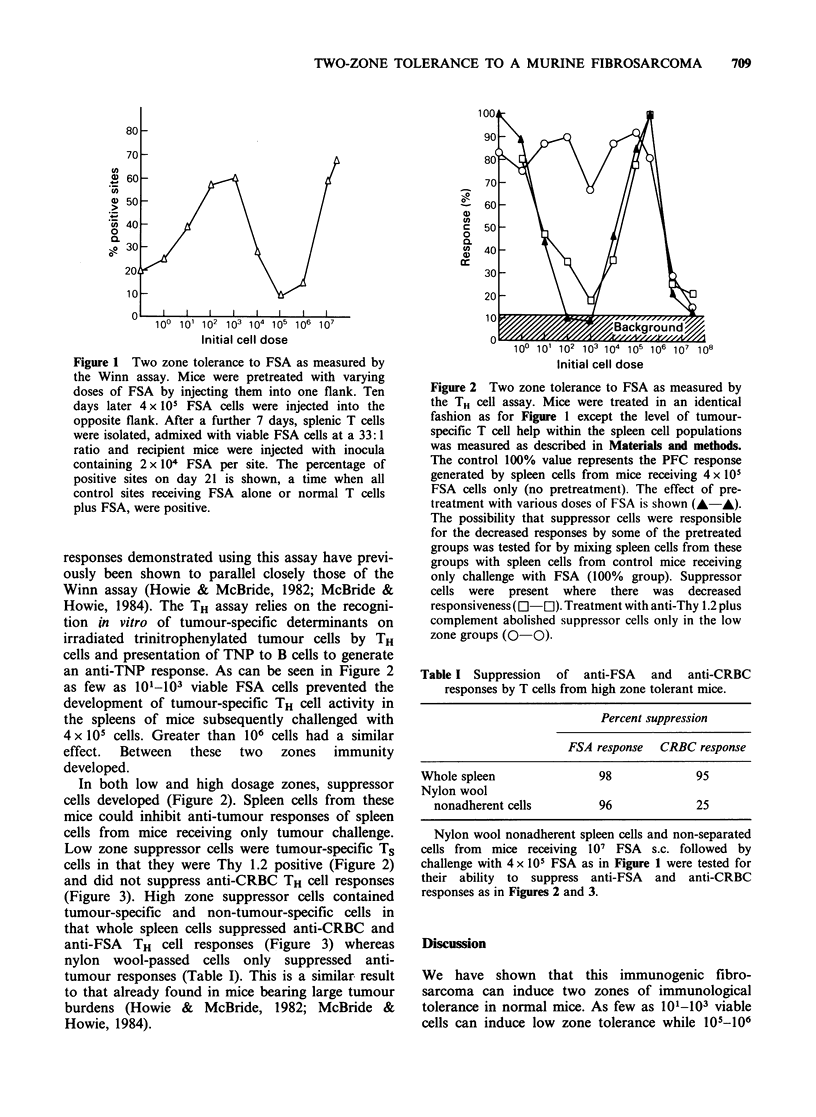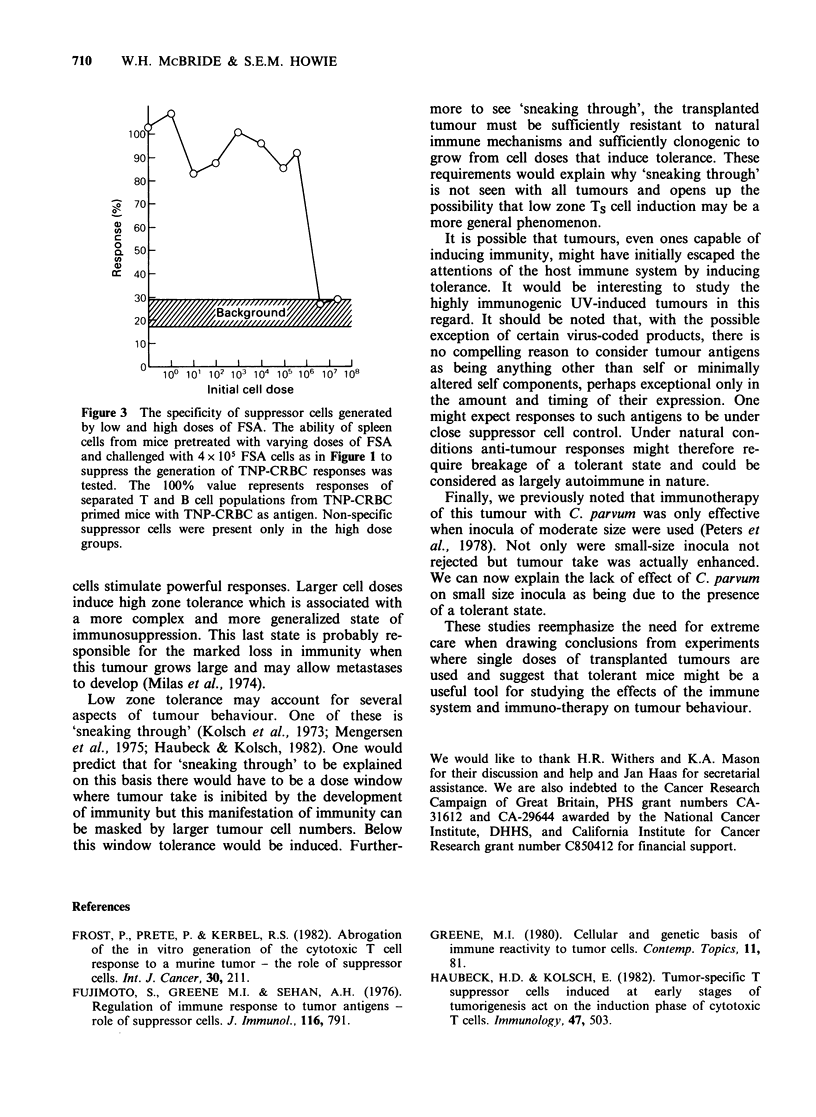Abstract
Small size inocula (10(1)-10(3) cells) of cells from a syngeneic methylcholanthrene-induced fibrosarcoma (FSA) induced tolerance when injected s.c. into C3Hf mice. Mice were unable to respond to subsequent challenge with moderate, immunogenic doses of FSA. Tolerance was demonstrated in an in vivo transfer (Winn) assay and an in vitro tumour-specific TH cell assay. Low zone tolerance was associated with the presence of tumour-specific TS cells in the spleen. Moderate size inocula (10(4)-10(6) FSA cells) were immunogenic but larger cell doses (greater than 10(6)) were again tolerogenic. In the high zone, tolerance was associated with both tumour-specific TS cells and non T suppressor cells that were not tumour-specific. These results support the view that immunogenic tumours, as they grow from small cell numbers, might be able to escape host surveillance by specifically tolerizing the immune system. They also suggest that large tumour burdens can interfere with the host's immune response by inducing suppressor cells.
Full text
PDF




Selected References
These references are in PubMed. This may not be the complete list of references from this article.
- Frost P., Prete P., Kerbel R. Abrogation of the in vitro generation of the cytotoxic T-cell response to a murine tumor: the role of suppressor cells. Int J Cancer. 1982 Aug 15;30(2):211–217. doi: 10.1002/ijc.2910300214. [DOI] [PubMed] [Google Scholar]
- Fujimoto S., Greene M. I., Sehon A. H. Regualtion of the immune response to tumor antigens. I. Immunosuppressor cells in tumor-bearing hosts. J Immunol. 1976 Mar;116(3):791–799. [PubMed] [Google Scholar]
- Greene M. I. The genetic and cellular basis of regulation of the immune response to tumor antigens. Contemp Top Immunobiol. 1980;11:81–116. doi: 10.1007/978-1-4684-3701-0_2. [DOI] [PubMed] [Google Scholar]
- Haubeck H. D., Kölsch E. Regulation of immune responses aginst the syngeneic ADJ-PC-5 plasmacytoma in BALB-c mice. III. Induction of specific T suppressor cells to the BALB/c plasmacytoma ADJ-PC-5 during early stages of tumorigenesis. Immunology. 1982 Nov;47(3):503–510. [PMC free article] [PubMed] [Google Scholar]
- Hellström K. E., Hellström I. Cellular immunity against tumor antigens. Adv Cancer Res. 1969;12:167–223. doi: 10.1016/s0065-230x(08)60331-0. [DOI] [PubMed] [Google Scholar]
- Howie S., McBride W. H. Tumor-specific T helper activity can be abrogated by two distinct suppressor cell mechanisms. Eur J Immunol. 1982 Aug;12(8):671–675. doi: 10.1002/eji.1830120809. [DOI] [PubMed] [Google Scholar]
- Kölsch E., Mengersen R., Diller E. Low dose tolerance preventing tumor immunity. Eur J Cancer. 1973 Nov-Dec;9(11-12):879–882. doi: 10.1016/0014-2964(73)90032-7. [DOI] [PubMed] [Google Scholar]
- MITCHISON N. A. INDUCTION OF IMMUNOLOGICAL PARALYSIS IN TWO ZONES OF DOSAGE. Proc R Soc Lond B Biol Sci. 1964 Dec 15;161:275–292. doi: 10.1098/rspb.1964.0093. [DOI] [PubMed] [Google Scholar]
- McBride W. H., Howie S. Paradoxical presence of T cell anergy during successful T cell-dependent tumour immunotherapy: characterization of a state of T cell 'amnaesia' following systemic administration of C. parvum. Clin Exp Immunol. 1984 Jul;57(1):139–148. [PMC free article] [PubMed] [Google Scholar]
- McBride W. H., Peters L. J., Mason K. A., Barrow G. The effect of Corynebacterium parvum on T cell dependent tumor regression. J Reticuloendothel Soc. 1980 Feb;27(2):151–158. [PubMed] [Google Scholar]
- Mengersen R., Schick R., Kölsch E. Correlation of "sneaking through" of tumor cells with specific immunological impairment of the host. Eur J Immunol. 1975 Aug;5(8):532–537. doi: 10.1002/eji.1830050805. [DOI] [PubMed] [Google Scholar]
- Milas L., Hersh E. M., Stringfellow D. A., Hunter N. Studies on the antitumor activities of pyrimidinone-interferon inducers. I. Effect against artificial and spontaneous lung metastases of murine tumors. J Natl Cancer Inst. 1982 Jan;68(1):139–145. [PubMed] [Google Scholar]
- Milas L., Hunter N., Mason K., Withers H. R. Immunological resistance to pulmonary metastases in C3Hf-Bu mice bearing syngeneic fibrosarcoma of different sizes. Cancer Res. 1974 Jan;34(1):61–71. [PubMed] [Google Scholar]
- Moser G., Tominaga A., Greene M. I., Abbas A. K. Accessory cells in immune suppression. I. Role of I-A+ accessory cells in effector phase idiotype-specific suppression of myeloma function. J Immunol. 1983 Oct;131(4):1728–1733. [PubMed] [Google Scholar]
- North R. J. The murine antitumor immune response and its therapeutic manipulation. Adv Immunol. 1984;35:89–155. doi: 10.1016/s0065-2776(08)60575-1. [DOI] [PubMed] [Google Scholar]
- Reinisch C. L., Andrew S. L., Schlossman S. F. Suppressor cell regulation of immune response to tumors: abrogation by adult thymectomy. Proc Natl Acad Sci U S A. 1977 Jul;74(7):2989–2992. doi: 10.1073/pnas.74.7.2989. [DOI] [PMC free article] [PubMed] [Google Scholar]
- Stutman O. Immunodepression and malignancy. Adv Cancer Res. 1975;22:261–422. doi: 10.1016/s0065-230x(08)60179-7. [DOI] [PubMed] [Google Scholar]


